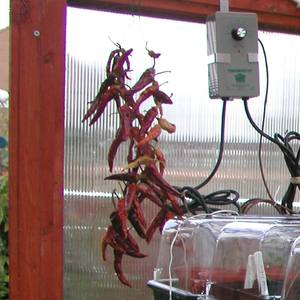Vegetables can be dried but as a general rule they’re not worth the bother. For example, root crops can be much better stored in peat or sand boxes in almost fresh conditions. Just because you can dry something doesn’t mean you should dry it. Sweetcorn can be dried, but is really far, far better frozen and even bottled. The only time we’d dry it is if we had a large amount and wanted it for the hens.
The real exceptions to the general rule on drying vegetables are dried tomatoes and dried beans, neither of which are vegetables, strictly speaking. However, when we had a problem with white rot causing our stored onions to rot we did dry some as a way of saving some of the crop.

Dried Strung Chilli Peppers in the Greenhouse
Drying Chilli Peppers
Chilli peppers are very easy to dry, except the thick-walled varieties such as jalapenos. The easiest way to do this is to simply string them up by passing a threaded needle through the base of the stems of a succession of chillies until you have a long line of them, rotating them so they point out in different directions as you add them.
When you’ve finished, tie a loop at the top and hang them up in a warm, dry place with good airflow.
Once dried they can remain strung as is often done in warmer climates or be crumbled to flakes and stored in airtight jars. Running through a coffee grinder will create a chilli pepper.
Drying Onions
- Use medium to large onions. Peel and cut them into ¼” (5mm) slices.
- Separate the slices into rings – the very small centres are difficult to dry satisfactorily so its best to use them up for cooking fresh.
- Dip the onions rings into boiling water for about 30 seconds, drain and pat dry with a towel or kitchen roll paper.
- Spread the onion rings onto trays and dry at a temperature not higher than 65°C/150°F/Gas Mark 0 until they are crisp and dry. (This will take about 3-4 hours).
- Once cooled, pack into bottles or jars with airtight lids. Store in a dry, dark place.
- When required, soak them in warm water for about 30 minutes. If they are to be fried or grilled, pat them dry with kitchen roll paper before use.
More on Drying & Dehydration
- Drying Apples & Pears – How to Dry Apples & Pears
- Drying Apricots, Peaches, Plums – How to Dry Apricots etc.
- Drying Fruits – How to Dry and Store Fruits, Fruit Leather
- Drying Runner & French Beans – How to Dry Runner & French Beans
- Drying Herbs – How to Dry and Store Herbs
- Drying Vegetables – How to Dry and Store Vegetables
- Sun Dried Tomatoes – How to Dry Tomatoes
- Drying Beans & Peas – How to Dry Beans & Peas at Home
- Drying Onions – How to Dry Onions


